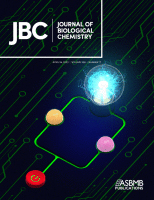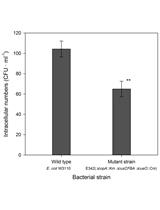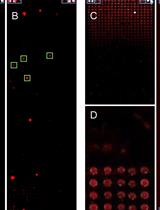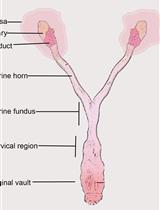- EN - English
- CN - 中文
Measuring Cytosolic Translocation of Mycobacterium marinum in RAW264.7 Macrophages with a CCF4-AM FRET Assay
用CCF4-AM FRET法检测RAW264.7巨噬细胞中海洋分枝杆菌的细胞质移位
发布: 2021年04月20日第11卷第8期 DOI: 10.21769/BioProtoc.3991 浏览次数: 3540
评审: Jason NeidlemanMei Po ChanAnonymous reviewer(s)
Abstract
The CCF4-AM Förster resonance energy transfer (FRET) assay is a sensitive approach to measure bacterial cytosolic translocation in live cells. The FRET pair hydroxycoumarin (donor) and fluorescein (acceptor) are linked by a CCF4-AM β-lactam ring, the substrate of β-lactamase. The exogenously added, neutral charged-FRET reagent can diffuse across the membrane and stay in the cytosol only once it is charged in the cytosol. When bacteria translocate from subcellular organelles (e.g., phagosomes) to the cytosol, the bacteria-associated β-lactamase cleaves the β-lactam ring, resulting in loss of FRET signal. Here we describe the fluorometer-based approach optimized for direct measurement of cytosolic translocation as a result of the EsxAB complex of Mycobacterium marinum in RAW264.7 cells.
Keywords: CCF4-AM (CCF4-AM)Background
The development of a β-lactamase reporter assay gave rise to the subsequent Förster resonance energy transfer (FRET) assay (Zlokarnik et al., 1998; Cavrois et al., 2002). Two fluorescence dyes, hydroxycoumarin (donor) and fluorescein (acceptor), are linked via a CCF4-AM (CCF2-AM in earlier reports) β-lactam ring. When excited at 405 nm, hydroxycoumarin emits at 450 nm (blue), which subsequently excites fluorescein to emit at 527 nm (green). Cleavage of the β-lactam ring by bacteria-associated β-lactamase results in loss of FRET and direct emission of hydroxycoumarin (blue) (Jones and Padilla-Parra, 2016). The CCF4-AM FRET reporter assay is versatile and has been been used for a variety of different applications, such as tracking molecular fusions (Jones and Padilla-Parra, 2016; Shaikh, et al., 2019), tracking delivery of biological cargos to the cytosol (Stone et al., 2018), and monitoring translocation of bacteria within cells (Charpentier and Oswald, 2004). Since Mycobacterium marinum also possesses β-lactamase (Flores et al., 2005), Simeone and colleagues exploited the FRET assay to track cytosolic translocation of Mycobacterium tuberculosis in THP-1 cells (Simeone et al., 2012). Recently, we applied this method for investigation of the role of EsxAB in cytosolic translocation of Mycobacterium marinum (Acosta et al., 2014; Zhang et al., 2016; Aguilera et al., 2020). RAW264.7 cells were infected with M. marinum and the results were obtained under a fluorometer, providing a quick, quantitative method for analysis of results. Furthermore, as Mycobacterium marinum is a BSL-2 pathogen and contains similarities in its ESX-1 locus (Tobin and Ramakrishnan, 2008), it provides a safe, direct way to investigate the EsxAB complex. Here we describe our procedure for direct monitoring of cytosolic translocation of Mycobacterium marinum in RAW264.7 cells via the CCF4-AM FRET assay using a fluorometer.
Materials and Reagents
- Inoculation loop (BD, catalog number: 220216)
- Cell Scraper (Fisherbrand, catalog number: 08-100-241)
- T-75 Flask (Thermo Scientific, catalog number: 12-566-440)
- 50 ml Centrifuge tube (Corning, catalog number: 352098)
- 6-well plate (Corning, catalog number: 3516)
- 10 ml syringe (Fisherbrand, catalog number: 14-955-459)
- 22 gauge needle (BD, catalog number: 305900)
- 27 gauge needle (BD, catalog number: 305109)
- 5 µm filter (Millex, catalog number: SLSV025LS)
- Pasteur pipette (Fisherbrand, catalog number: 13-678-6b)
- Aluminum Foil (Fisherbrand, catalog number: 01-213-102)
- Thin Wall Cuvette (Fireflysci, catalog number: 30FL)
- 435 nm long-pass filter (Andover Corporation, catalog number: 435FG03-50S)
- 7H9 media (Difco, catalog number: 271310)
- OADC Enrichment (BD, catalog number: 211886)
- Tween-80 (Sigma-Aldrich, catalog number: P1754)
- Kanamycin Monosulfate (Gold Bio, catalog number: K-120-5)
- DMEM media (Gibco, catalog number: 10566-016)
- Fetal Bovine Serum (Gibco, catalog number: A4766801)
- Penicillin and Streptomycin (Gibco, catalog number: 15070063)
- Phosphate buffered saline (Sigma-Aldrich, catalog number: P3813)
- CCF4-AM FRET Loading Solutions (Life Technologies, catalog number: K1085)
Note: This kit contains Solution A, Solution B, and Solution C as described in the procedure. - DMSO (Sigma-Aldrich, catalog number: D8418)
- 4% Paraformaldehyde
- NaCl (Fisherbrand, catalog number: 18-606-420)
- MgCl (Fisherbrand, catalog number: 18-604-047)
- CaCl2 (Fisherbrand, catalog number: AA4428030)
- KCl (Spectrum Chemical, catalog number: 18-605-507)
- Glucose (Sigma-Aldrich, catalog number: G7021)
- 4-(2-Hydroxyethyl)piperazine-1-ethanesulfonic acid, N-(2-Hydroxyethyl)piperazine-N′-(2-ethanesulfonic acid (HEPES)) (Fisher Bioreagents, catalog number: BP310)
- Tris (Fisher Bioreagents, catalog number: BP152-500)
- EM Media (see Recipes)
Equipment
- Biosafety Cabinet (Labconco)
- Vortex (VWR, catalog number: 58816-121)
- Hemocytometer (Hausser Scientific, catalog number: S17040)
- Inverted Light Microscope (VWR, catalog number: Vistavision)
- Cell Imaging System (Life Technologies, catalog number: 4471136)
- Spectrophotometer (Amersham Biosciences, model: Ultrospec 10)
- Table Top Centrifuge (Eppendorf, catalog number: 5810R)
- CO2 Incubator (VWR, catalog number: 3078)
- Fluorometer (ISS, catalog number: K2)
- Incubator Shaker (VWR, catalog number: 1585)
- Hot Plate/Stirrer (ThermoFisher Scientific, catalog number: SP131325)
- pH meter (Mettler Toledo, catalog number: 30266626)
Procedure
文章信息
版权信息
© 2021 The Authors; exclusive licensee Bio-protocol LLC.
如何引用
Readers should cite both the Bio-protocol article and the original research article where this protocol was used:
- Aguilera, J. and Sun, J. (2021). Measuring Cytosolic Translocation of Mycobacterium marinum in RAW264.7 Macrophages with a CCF4-AM FRET Assay. Bio-protocol 11(8): e3991. DOI: 10.21769/BioProtoc.3991.
- Aguilera, J., Karki, C. B., Li, L., Reyes, S. V., Estevao, I., Grajeda, B. I., Qi Zhang, Arico, C. D., Ouellet, H. and Sun, J. (2020). Nα-Acetylation of the virulence factor EsxA is required for mycobacterial cytosolic translocation and virulence. J Biol Chem 295(17): 5785-5794.
分类
微生物学 > 微生物-宿主相互作用 > 细菌
细胞生物学 > 基于细胞的分析方法 > 细菌感染
您对这篇实验方法有问题吗?
在此处发布您的问题,我们将邀请本文作者来回答。同时,我们会将您的问题发布到Bio-protocol Exchange,以便寻求社区成员的帮助。
Share
Bluesky
X
Copy link













